Every Magic player has a strategy they detest to have deployed against them. Some folks quit the second they see Ruin Crab; others put “no LD” in their game requests. One of the more frustrating mechanics in the game, as it involves a physical component, is your opponent picking up your library to search for and exile cards. These effects can be divvied up into three categories: Extraction, Eradication, and Extirpation.
Extraction is naming a card or searching for a card—Cranial Extraction, Memoricide, Unmoored Ego, etc.—and generally requires a knowledge of the opponent’s deck. Eradication is the reactive removal of a threat, followed by the ability to exile other copies of that card—Shimian Specter, Quash, Crumble to Dust. Extirpation is a more narrow, but generally cheaper effect, and removes a face-up card and the copies of that card—Extirpate, Surgical Extraction, Haunting Echoes. You feel violated when someone else handles your deck, especially when they’re doing so to incapacitate your strategy.
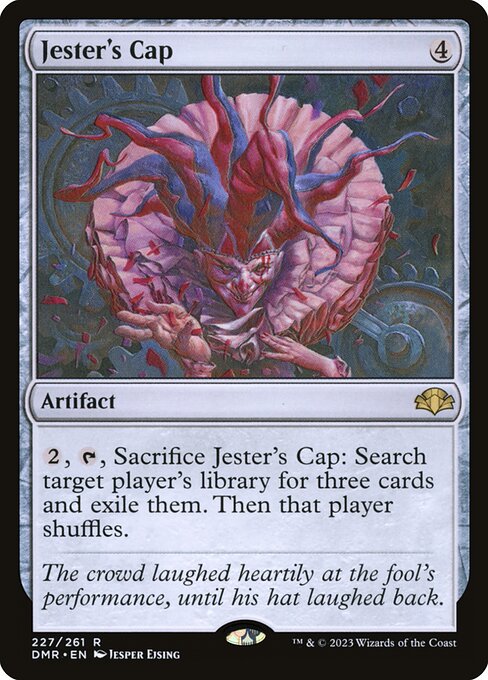
One of the game’s earliest chase rares—the sort of card designed to get enfranchised players to continue to buy packs, even once they had most of the cards they need—was Jester’s Cap in Ice Age. This was, of course, back in the frontier days of Magic, when a singleton copy of The Hive might be the way you closed out a game. Jester’s Cap was designed long before tournament rules were consolidated and before card advantage was more than a conceptual seed.
Statistically, Jester’s Cap does nothing—you may remove three crucial cards from an opponent’s deck; but they still have fifty-seven cards, presumably good enough to justify running. You’ve spent six mana to skim three cards out of their deck—decent against some combo decks, but otherwise as useless as milling a few cards here and there. That said, hitting someone with a Jester’s Cap felt great; it remained expensive and celebrated, even returning with fanfare in Ninth Edition. I run a singleton in my Karnboard in Modern, although I’ve yet to cast it. It’s also seen a bit of a resurgence in Competitive EDH, where it can come down off Mana Crypt and a Mox or two and peel your opponent’s combo out of their deck.
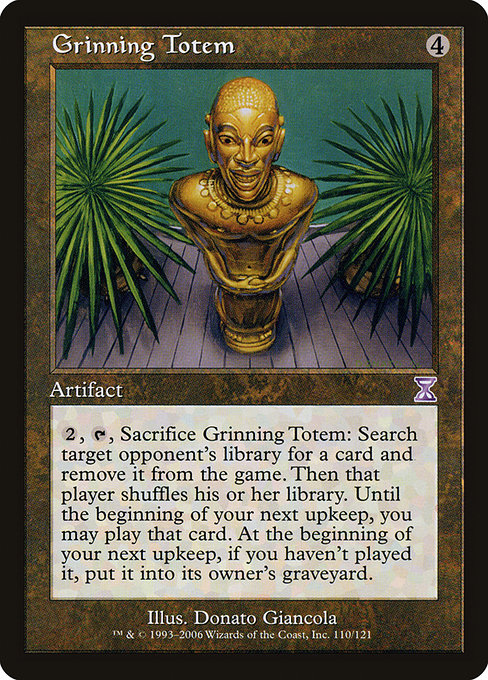
Next year Mirage brought another card with more buzz than backbone. Grinning Totem was one third of a Jester’s Cap, but you could either play the card or dump it to your opponent’s graveyard. For that, you’d pay six total mana—the same cost as casting and activating the Cap. Praetor’s Grasp from New Phyrexia is half the cost, allows you to play the spell at your convenience rather than having a single turn window, and doesn’t require you to reveal the card when you exile it. This was basically an upgrade for half the cost, and the presumptive new mana cost point for such effects. Grinning Totem returned in Time Spiral, making it also Modern legal—although you’d have to be a bolder person than I to run it, even in a wish board.
After Mirage, “search and exile” effects (as yet unnamed, although often colloquially called “capping”) went dormant, with Tempest’s Lobotomy and the cards it inspired (i.e., the Urza’s Destiny cycle of Scour, Quash, Eradicate, Sowing Salt, and Splinter) taking over. Lobotomy saw significant standard play, as it allowed control decks to both counter a current threat and strip the possibility of future threats. In other words, it’s both reactive and proactive, and demonstrated that simply capping a player without other benefits didn’t justify a card. This group of cards is different from our “extraction” effects, which are designed to preemptively strip cards, rather than strip cards in response.
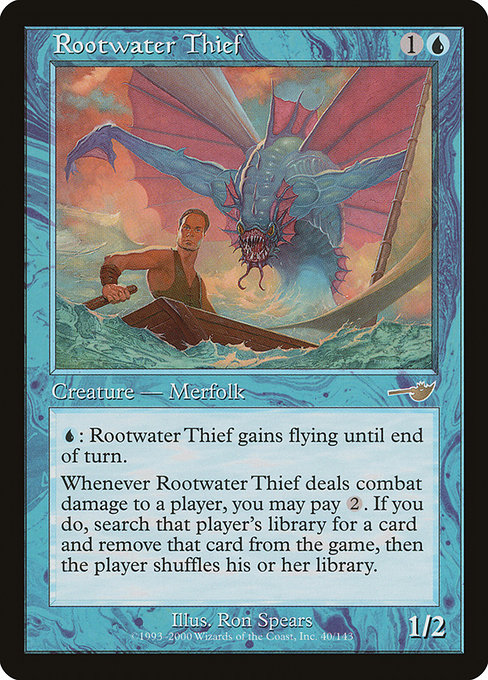
In February of 1999, Mike Long won the Invitational and thus was granted a chance to pitch a card to Wizards; he pitched a vanilla Merfolk with an activated Jump for U, and Wizards tacked on a saboteur trigger to exile a card, almost as though to punish Long for creating one of Magic’s first true combo decks in Prosperous Bloom. Although it debuted with great fanfare, Rootwater Thief doesn’t hold up—in a modern context, paying mana to remove a single copy upon damage is not even close to worth it, and the density and diversity of threats in the modern game means that your opponent will just win with whatever else they have in hand.
Back when it was designed, though, Rootwater Thief was meant to oppose bolder archetypes—it was initially praised as a solution to the Trix decks that were dominating the metagame, and was designed during a time when powerful combos depended on finding key cards, like Survival of the Fittest, Attunement, and Stroke of Genius. But putting an extraction effect on a fragile two-drop that has to spend U to connect and another two mana to extract was never enough to stymie these decks. Rootwater Thief has never been reprinted, and is essentially forgotten as a tournament card, although Rogue and Merfolk Commander decks often run it as a cheap, evasive member of their tribe.
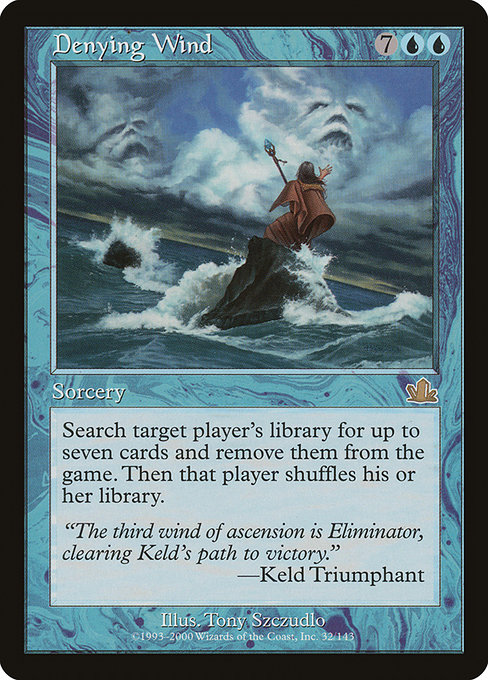
You can see how overvalued “Capping” as an effect was in cards like Prophecy’s Denying Wind. Plague Wind, Vitalizing Wind, and Searing Wind win games, Blessed Wind is a two-turn Fog, and Denying Wind—the splashiest card in the “best color” at the time—cost 7UU to extract seven cards your opponent probably wasn’t going to draw anyway.
Odyssey bifurcated extraction effects into ones we still see now—proactive and reactive—in the printing of Extract and Haunting Echoes. Both were casual staples that held surprisingly high prices, because they’re splashy effects, and because players were still less adept at evaluating the benefits of skimming out cards. Nothing had changed since the days of Jester’s Cap. Extract—the simplest and cheapest iteration of the effect—never saw much play, because even newer players soon realized that it’s not worth trading a card from your hand for a potential card from their deck; tournament players would rather Duress or counter the threat instead of rolling the dice. If it were a cantrip or had some other minor effect, maybe—Rootwater Thief still gets in for damage, after all, and can repeatedly extract cards—but a vanilla Extract effect needs something more to justify going down a card.
Haunting Echoes fared better, as a well-timed Echoes could defang a deck in a metagame of Flashback and Threshold. That said, it was mostly relegated to the sideboard, and fell out of favor as the metagame shifted to U/G Madness and Psychatog-based decks. It still saw top-level player in Onslaught Standard, as it counteracted various Reanimator and Patriarch’s Bidding decks, but five mana is a big ask. Extract has never been reprinted, while Echoes was brought back in M10 and M11, so is technically legal in Modern.
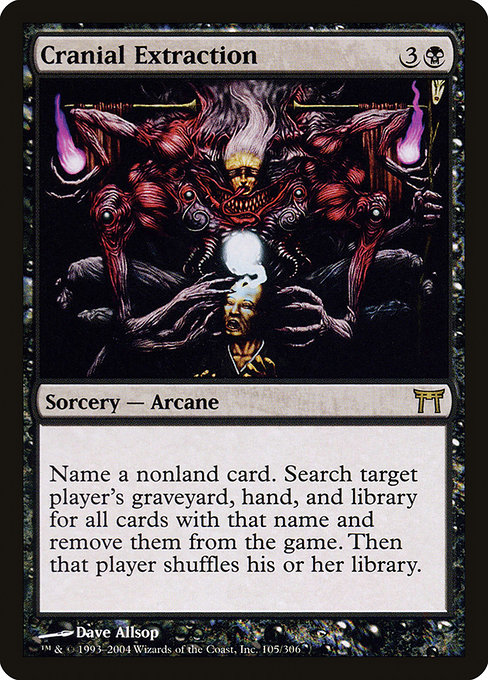
With Champions of Kamigawa, we saw the simplest iteration—and the namesake of the mechanic. Cranial Extraction requires an awareness of the metagame if you choose to run it in the main deck. Its closest analogue is Cabal Therapy (and yes, I ran them together in several 1-3 Extended Rock decks back in 2005 or so). I remember playing Standard back then and having to talk folks out of running Cranial Extraction in the main (and myself out of running it in the sideboard sometimes). Like “punisher” cards before it, Cranial Extraction will come off as the best case scenario when theorizing and the worst case when topdecking.
It’s an important safety valve, like Leyline of the Void or Field of Ruin, but players back in Ravnica Standard ran it as some kind of indirect card advantage. It was important to hamstring Gifts Ungiven or Heartbeat of Spring, but less useful to counteract the sort of midrange mayhem that Ravnica: City of Guilds brought a year later. Cranial Extraction wasn’t Kamigawa Block’s only extraction effect: aside from the Lobotomy cycle, Saviors of Kamigawa gave us Neverending Torment, which it’s safe to say was never worth it. It’s bad enough that Extraction effects don’t directly affect the board; Neverending Torment’s Epic ability means you’ll never affect the board again in that game.
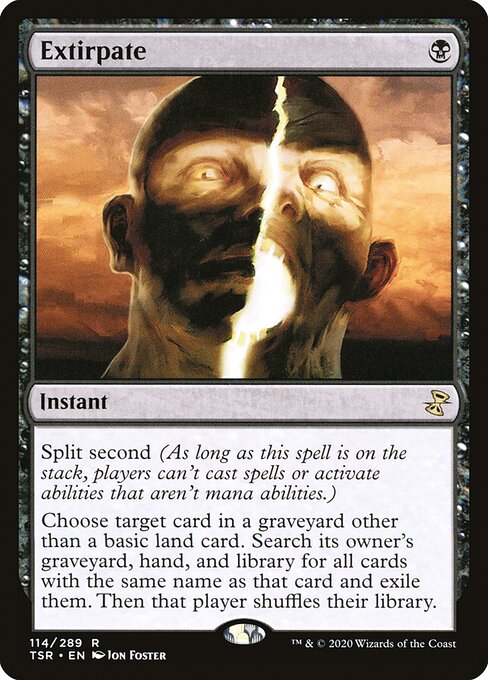
Magic’s wandering-in-the-wilderness years—2006-2008—were home to two very powerful but limited iterations of extraction effects. Planar Chaos brought us universal staple Extirpate, a mini-Haunting Echoes that was the best tool for the job for years until the printing of Surgical Extraction. Future Sight brought combo finisher Bitter Ordeal—living up to Storm’s legacy, it’s only ever played unfairly. It was designed to reward innovators, but generally is just the finisher for various loops to exile an opponent’s entire library.
Meanwhile, Eventide’s Nightmare Incursion is the black sheep of the subclass of cards—it’s basically Denying Wind at 5B in mono-black decks, but scales really poorly outside of multicolored decks, and has no effect beyond extracting cards. I play it in The Gitrog Monster once Urborg, Tomb of Yawgmoth comes out, but it’s too pricey and low-impact for anything but fun games. Zendikar gave us Sadistic Sacrament, which (unkicked) is Jester’s Cap for half the mana, and at 7BBB is two Denying Winds.
Wizards brought Haunting Echoes back in M10 as a statement of purpose for Black. The great cultural reset of the Core Set meant a re-standardization of color philosophy, and Black was cemented as the core Extraction color. Since then, some of the better Extraction effects have been multicolored—Thought Hemorrhage and Slaughter Games are upgraded Memoricide in exchange for adding Red, and Unmoored Ego is Lost Legacy without qualifiers.
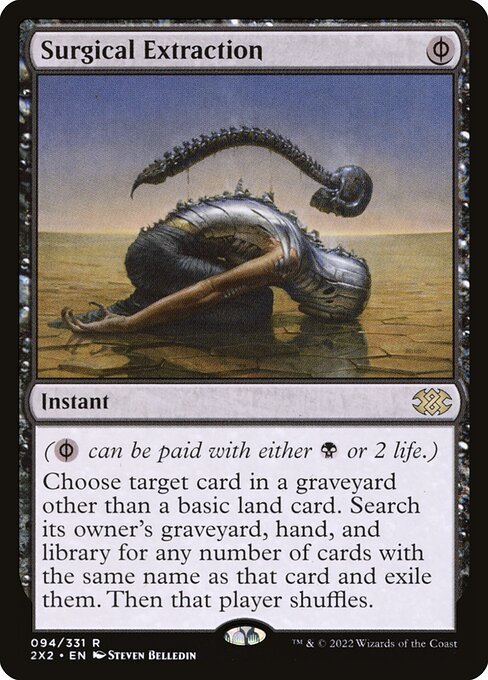
Scars of Mirrodin moved from innovation to iteration. Surgical Extraction can be cast for free, mostly obviating the original Extirpate and relegating it to budget-conscious sideboards. Memoricide lived up to its legacy as a Cranial Extraction reprint, with players who missed the great Cranial debate of 2004 running Memoricide as a way to extract various Swords, Jaces, and Hawks, instead of running actual removal.
It took fifteen years, but Wizards had now landed pretty solidly on the right costs for extraction effects. The villainous joy of capping someone has never lost its savor, and the backlash still comes up in LSV’s set reviews and the cEDH forums. That’s quite a legacy for a game mechanic that got its start in a goofy and ineffectual card like Jester’s Cap.
A lifelong resident of the Carolinas and a graduate of the University of North Carolina, Rob has played Magic since he picked a Darkling Stalker up off the soccer field at summer camp. He works for nonprofits as an educational strategies developer and, in his off-hours, enjoys writing fiction, playing games, and exploring new beers.

